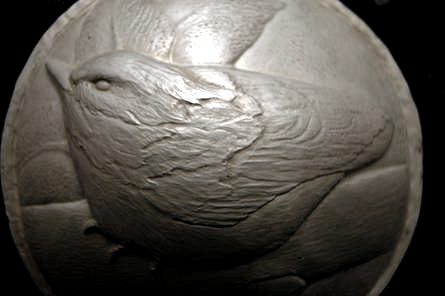|
©
Henry Spencer: Pill Box Cover
The object
pictured includes metalsmithing nomenclature found defined in the Glossary.

Completed Sterling Silver Nuthatch with leaves, 2 inch diameter,
pickled finish.

Completed Sterling silver Nuthatch with leaves, 2 inch diameter, patinated.
These photos start out about half way through the work on this piece.
It started out as a sheet of .040", 18-gauge, stock 2¼
inches in diameter. It is my hope to shoot another piece earlier in
the process

This represents then end of the beginning. Everything is in place,
there is nothing wrong that can't be fixed, but the contour of the
piece is significantly out of kilter. The branch has at least three
separate contours of its own and needs serious work, the lower leaf
does not look like it springs from behind the branch, and it should, etc.

Showing detail of beak: This area represents considerable skill.
There are 5 separate planes in this piece: the bird's shoulder, the
bird's beak and tail, the branch, 3 set of leaves and the background
plane. The beak, occupying its own level, intersects the background
plane and the nexus of 2 levels of leaves. And the tip of the beak is
only a quarter inch from the edge of the piece. The detail below
shows this area. To deal with this kind of situation you need
constantly carry forward and control early detail as later details
increase volume and surface area. One needs to, from the very first
steps, constantly prepare for the time when this area has to be
finished and blend in with everything else. I feel it would be
conservative to say that over the course of the piece this one area
was worked over more than seventy five to a hundred times, and was
one of the last areas perfected.

Another example of nexus of planes. The worry is not getting a
foreground detail to sit on top of numerous receding levels; it
is getting the background plane to run under the foreground details,
in this case the tip if the tail and the edge of the branch. Making
that little slot of background plane that runs between the branch and
the tail match and integrate with the rest of the background plane
really does represent the most technical accomplishment in this piece.

Showing sharp distinction of level separation at junction of tail,
body and branch with the background level.
It should be mentioned that this piece made very little use of
repousse techniques. Once the original cartoon of the bird on the
branch and the overall contour of the piece were set repousse was
used only to touch up a spot or two. Giving myself so much volume by
working off such a highly domed piece allowed significant use of
pushing a level back down to 'apparently' lift the level next to it.
The foliage was established almost entirely in this way.

Detail of previous photo. It should be noted that most of the primary
interior lines forming the head, shoulder and wings of the bird were
begun many steps back. This is not a case where details were added on
after; yes they are refined at this point but the patina of
reflective surfaces and edges of the detail areas as they blend in
with adjacent details has been built up through many passes with
chasing tools.

This picture represents the finished piece: The only
significant difference between this image and the previous one is a
significant amount of volume and couture work on the branch the bird
is sitting on. The final step being cutting away the working edge
using chasing tools: not a saw, and then oxidation.
Back
to The Creative Process
Back
to Home Page |